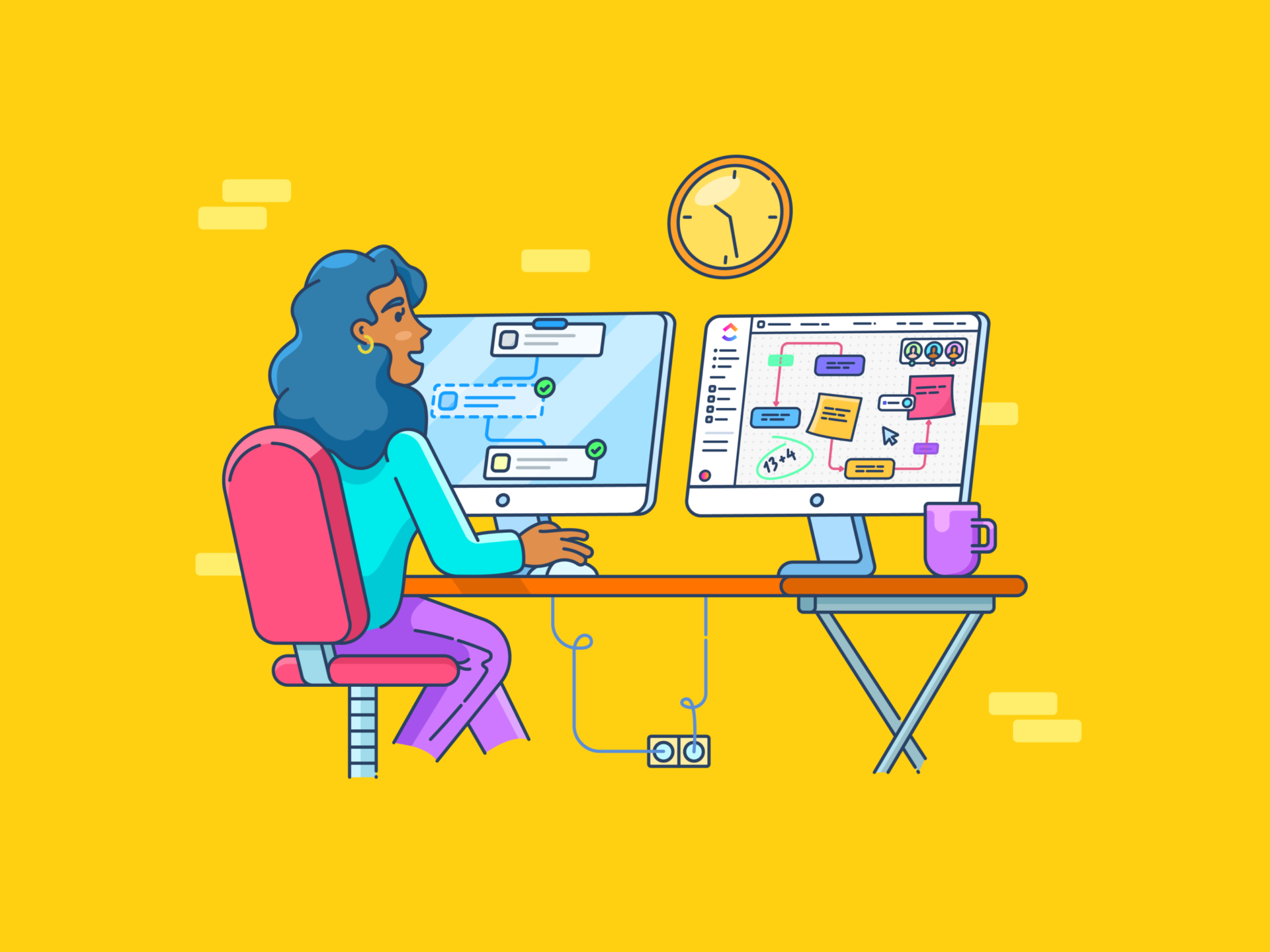Search engine optimization (SEO) is a never-ending process of trial and error. The pressure to find the right keywords and optimize content is overwhelming. And when you think you’ve nailed it, Google hits you with a new update, and suddenly, your search engine rankings are in freefall.
But what if we told you that AI tools like ChatGPT can manage and speed up your SEO workflows?
ChatGPT acts as your personal SEO assistant, helping you fine-tune content that both search engines love and your audience connects with. In fact, a survey shows that 58% of professionals use it to generate and optimize content, 20% for metadata, 15% for keyword research, and 8% for benchmark analysis.
However, ChatGPT’s results are only as good as your instructions. This guide shows you how to craft perfect ChatGPT SEO prompts and shares 30+ examples to level up your strategy.
30+ ChatGPT SEO Prompts for Better On-Page Optimization
What are ChatGPT SEO Prompts?
ChatGPT SEO prompts are carefully written instructions you give to ChatGPT to get an SEO task done, such as suggesting keywords, creating an outline, optimizing image alt text, crafting an SEO-friendly blog, and more.
ChatGPT uses extensive training data to process these prompts and generate tailored suggestions that align with your search intent, saving you time and effort.
Here’s what makes a good SEO prompt:
- Clarity: Clearly state your request, such as ‘Generate a list of high-volume, low-competition keywords for local SEO in the dental industry’
- Focus: Stick to one request at a time. Instead of asking for both keyword research and a content outline, separate them into two prompts
- Context: Provide relevant details, like your target audience, industry, location, or competitors. Example: ‘Suggest blog topics for a real estate website targeting first-time homebuyers in California’
- Actionable: Ask for a tangible outcome. Instead of ‘Give SEO tips,’ try ‘List five on-page SEO improvements for a WordPress blog’
- Length and depth: Specify how detailed you want the response. For example, ‘Provide a 200-word explanation on optimizing meta descriptions for eCommerce sites’
Benefits of Using ChatGPT SEO Prompts
SEO doesn’t have to be complicated, and ChatGPT prompts ensure that. Here’s how:
💡 Break through writer’s block instantly: ChatGPT handles SEO brainstorming with open-ended prompts like ‘What are the latest trends in sustainable fashion SEO?’, unlocking fresh content angles and keyword opportunities
⚖️ Keep your content style consistent: Set the tone once (friendly and conversational or formal APA style) and ChatGPT ensures every piece stays cohesive and on-brand
🔍 Optimize on-page SEO effortlessly: Use prompts to refine content with relevant keywords, FAQs, and LSI keywords for better rankings (without keyword stuffing)
📈 Focus on strategy more: ChatGPT handles SEO groundwork so you can prioritize creativity and analysis. No wonder 71% of marketers say generative AI frees them up for bigger wins
How to Create Effective ChatGPT SEO Prompts?
Whether creating ChatGPT prompts for marketing, sales, or SEO, give the AI clear, context-rich instructions. Nail this, and you will get SEO-driven, well-structured content that ranks.
So, follow these best practices to generate result-oriented SEO prompts 👇
1. Be specific about what you want
ChatGPT works best when given clear direction. Before you write the prompt, identify the SEO task you need help with.
- Need keyword ideas? Ask, ‘Generate 10 long-tail keywords for [topic] with low competition and high search intent’
- Looking for a blog post outline? Specify, ‘Create an SEO-friendly blog outline for [topic] with H1, H2, and H3 tags’
- Want to optimize a paragraph? Instruct, ‘Rewrite this paragraph to naturally include the keyword “[target keyword]” while improving readability’
2. Provide context for better results
Context is key to getting more relevant answers from ChatGPT. Think about what information would help guide the AI. This could include:
| Category | Description | Examples |
| Target topic or keyword | What’s the main focus of the content? | ‘Digital marketing for startups’ or ‘AI-powered SEO tools’ |
| Audience | Who is this content for? | ‘Written for beginners’ or ‘Targeting small business owners’ |
| Purpose | What’s the goal of this content? | ‘To educate,’ ‘To generate leads,’ or ‘To rank higher on search engines’ |
| Tone or style | How should it sound? | ‘Use a persuasive and data-driven tone’ or ‘Keep it friendly and conversational’ |
| Role | What perspective should the content take? | ‘Act as an SEO expert,’ or ‘Write like a digital marketing coach’ |
3. Be clear about the output format
SEO content often requires strict formatting, such as titles under 60 characters, keyword placement in headings, or a JSON-LD schema for structured data. Tell ChatGPT exactly what format or criteria you want in the answer to avoid ambiguity and unnecessary edits.
Some examples of instructions are:
| Category | Bad prompt | Good prompt |
| Number of items | Give me some blog title ideas for a fitness blog | Provide five blog title ideas for a fitness blog |
| Character or word limits | Write a meta description for a blog on email marketing | Write a meta description under 155 characters for a blog on email marketing |
| Output type | Suggest keywords for digital marketing | List 10 long-tail keywords for digital marketing in a table with search volume and competition level |
| Formatting request | Write a LinkedIn post about content marketing | Write a LinkedIn post about content marketing. Format it as: Hook (first sentence, attention-grabbing) Main content (2-3 short paragraphs with insights or tips) CTA (Encouraging engagement or action) |
| Examples to include | Write an SEO-friendly blog outline for ‘Remote Work Productivity’ | Create an SEO-friendly blog outline for ‘Remote Work Productivity.’ Use examples of successful remote companies and real-world productivity challenges to make it actionable |
4. Use SEO data and reference materials
ChatGPT doesn’t have live search data, so it doesn’t know the actual search volumes or keyword difficulty. But you can feed it with specific SEO details like:
- Keyword research (search volume, competition level)
- User intent (informational, transactional, navigational)
- Competitor insights (common content structures, word count)
- Search engine results page (SERP) trends (featured snippets, listicles, FAQs)
As of GPT-4, you can upload documents like brand guidelines or past blog examples to show the AI your preferred tone, structure, and formatting. GPT-4o can also browse the internet, so if you have links to studies, competitor blogs, or reference materials, paste them directly into the prompt for better accuracy.
⚠️ Note: These features are only available with a ChatGPT Plus subscription.
📮 Insight: 62% of our respondents rely on conversational AI tools like ChatGPT and Claude. Their familiar chatbot interface and versatile abilities—to generate content, analyze data, and more—could be why they’re so popular across diverse roles and industries.
However, if a user has to switch to another tab to ask the AI a question every time, the associated toggle tax and context-switching costs add up over time.
Not with Brain, though. It lives right in your Workspace, knows what you’re working on, can understand plain text prompts, and gives you answers that are highly relevant to your tasks! Experience 2x improvement in productivity with !
5. Refine and iterate
Don’t accept ChatGPT’s first answer as final. If details, structure, or keywords are missing, tweak the prompt.
📌 For example, if ChatGPT’s outline on ‘Effective Marketing Strategies for Small Businesses’ lacks a key section, like ‘budget planning, refine it with a follow-up:
✔️ Great outline! Add a section on budget considerations for each strategy.
Need a different tone or more variety? Ask:
✔️ Rewrite this in a more conversational style.
✔️ Give me five more examples.
Keep iterating until the content gets closer to your ideal outcome.
💡 Pro Tip: Use step-by-step prompts instead of one big request for better SEO results. This ‘chain-of-thought’ approach breaks down a broad task into smaller steps and keeps content focused.
📌 Example: For keyword research:
- Prompt 1: Give me 15 long-tail keywords related to [topic]
- Prompt 2: For each keyword, suggest the search intent (what the user is likely looking for)
- Prompt 3: Now, draft an outline for a blog targeting the first keyword on the list
30 Examples of ChatGPT SEO Prompts
To get started, here are 30+ examples of ChatGPT prompts tailored to various SEO tasks. Feel free to copy, tweak, and use them in your workflow.
(For convenience, we’ve grouped them into various categories.)
A. Keyword research prompts
1. List 10 broad seed keywords for [industry] that cover different aspects of the niche.
✨ Did you know? Brain users can choose from multiple external AI models, including GPT, Gemini, and Claude, right from their Workspace! The power of the world’s best LLMs, all within ! 🚀
2. Generate a list of long-tail keywords related to [product] to drive more traffic to the product page.
![Generate a list of long-tail keywords related to [product] to drive more traffic to the product page : chatgpt seo prompts](https://.com/blog/wp-content/uploads/2025/04/Generate-a-list-of-long-tail-keywords-related-to-product-to-drive-more-traffic-to-the-product-page-Dashboard-1400x1018.png)
3. List 10 latent semantic indexing (LSI) keywords related to [primary keyword] that commonly appear in top-ranking content.
![List 10 latent semantic indexing (LSI) keywords related to [primary keyword] that commonly appear in top-ranking content Dashboard : chatgpt seo prompts](https://.com/blog/wp-content/uploads/2025/04/List-10-latent-semantic-indexing-LSI-keywords-related-to-primary-keyword-that-commonly-appear-in-top-ranking-content-Dashboard-1400x577.png)
![List 10 latent semantic indexing (LSI) keywords related to [primary keyword] that commonly appear in top-ranking content Dashboard : chatgpt seo prompts](https://.com/blog/wp-content/uploads/2025/04/List-10-latent-semantic-indexing-LSI-keywords-related-to-primary-keyword-that-commonly-appear-in-top-ranking-content-Dashboard-1400x577.png)
4. Group these keywords into topic clusters based on search intent and semantic relevance. [Insert keyword list]


5. Recommend blog post angles for these keyword clusters, focusing on search intent and audience needs.


B. Competitive analysis prompts
6. My blog [insert blog link] focuses on eCommerce SEO, similar to [competitor website]. Compare both blogs and identify topics and subtopics they’ve covered extensively, but I haven’t. Suggest high-impact content opportunities to close the gap.
7. I’m in the eCommerce SEO industry. Find keywords where [competitor website] outranks [my website]. Identify weak spots like low-quality backlinks or thin content to outrank them. [Insert competitor’s blog page link]
C. Content ideation & creation prompts
8. Create a content brief on [topic]. Include ‘word count,’ ‘primary keyword,’ ‘meta description,’ ‘meta title suggestion,’ ‘H1 suggestions,’ and ‘instructions for writers.’


9. Write a short (max 120 words), SEO-friendly introduction for a blog on [topic] using the keyword naturally. Provide two versions:
- A straightforward intro on what the article covers
- A problem-driven introduction highlighting an issue the [topic] solves


10. Outline a comprehensive article on [topic]. Include six main sections with brief bullet points on what to cover in each.


11. You’re an expert in [industry] and its applications. Write a 1,500-word blog post on [topic] based on this outline. Incorporate the following keywords throughout to boost search engine optimization. [Insert outline and keyword list]


12. Provide a concise conclusion for a blog post on [topic]. It should summarize key points and include a call-to-action (like encouraging a comment or newsletter sign-up).


13. I’m writing a blog post on [topic]. Suggest ten titles, each under 60 characters, that include the exact keyword. The titles should be engaging and appealing to the audience.


D. On-page SEO prompts
14. I’m writing an article about ‘[topic]. What would be the best SEO-friendly URL structure?


15. I plan to write a comprehensive guide about [topic]. How should I structure my header tags for SEO?


16. How can I strategically place CTAs in my [masterclass topic] to maximize sign-ups and attendance?
![How can I strategically place CTAs in my [masterclass topic] to maximize sign-ups and attendance](https://.com/blog/wp-content/uploads/2025/04/How-can-I-strategically-place-CTAs-in-my-masterclass-topic-to-maximize-sign-ups-and-attendance-Dashboard-1400x571.png)
![How can I strategically place CTAs in my [masterclass topic] to maximize sign-ups and attendance](https://.com/blog/wp-content/uploads/2025/04/How-can-I-strategically-place-CTAs-in-my-masterclass-topic-to-maximize-sign-ups-and-attendance-Dashboard-1400x571.png)
17. Based on my sitemap, suggest five internal linking opportunities and possible anchor texts of no longer than five words for my [topic] blog post. [Insert your website link]
18. Write an alt text (under 125 characters) for an image about [image description].
![Write an alt text (under 125 characters) for an image about [image description].](https://.com/blog/wp-content/uploads/2025/04/Write-an-alt-text-under-125-characters-for-an-image-about-image-description-Dashboard-1400x370.png)
![Write an alt text (under 125 characters) for an image about [image description].](https://.com/blog/wp-content/uploads/2025/04/Write-an-alt-text-under-125-characters-for-an-image-about-image-description-Dashboard-1400x370.png)
E. Content optimization prompts
19. Rewrite this article with SEO best practices, including keywords like [insert keywords], meta descriptions, and subheadings. [Insert article link]
20. Generate an SEO-friendly meta title (60 characters max) and description (160 characters max) for a blog on [topic]. Place the keyword near the beginning for better search visibility.


21. Summarize this blog post in bullet point format for improved readability. [Insert blog post link]
22. Evaluate the readability of this blog post. Shorten lengthy paragraphs, use bullet points, and improve the format for a more visually appealing layout: [Insert blog post link]


23. My blog post [topic] has a 70-character title tag. Suggest a revised SEO-friendly title that captures the essence of the post and fits within the optimal character limit.


24. Proofread this blog post to identify and correct any grammatical errors, typos, and mistakes: [Insert blog post link]
F. Local SEO prompts
25. Examine the local SEO strategies of the top three competitors for a [type of business] in [city, state]. Provide insights on their keyword strategy, backlink profile, and Google Business Profile optimization. [Insert competitors’ website link]
26. Develop a content marketing plan to boost the local SEO of a multi-location [your business] in [your market localization]. Include localized blog posts, product/service spotlights, and partnerships with local influencers.


G. Technical SEO prompts
27. I run an eCommerce store with multiple product categories and subcategories. My website is [insert link]. Generate a valid XML sitemap for these pages: [insert all webpage links]
28. Generate an FAQ schema markup for the following questions and answers to improve search visibility: [List your questions]
29. I run an eCommerce store on [website name], where products appear under multiple categories. How do I add canonical tags correctly?
![I run an ecommerce store on [website name], where products appear under multiple categories. How do I add canonical tags correctly](https://.com/blog/wp-content/uploads/2025/04/I-run-an-ecommerce-store-on-website-name-where-products-appear-under-multiple-categories.-How-do-I-add-canonical-tags-correctly-Dashbaord-1400x637.png)
![I run an ecommerce store on [website name], where products appear under multiple categories. How do I add canonical tags correctly](https://.com/blog/wp-content/uploads/2025/04/I-run-an-ecommerce-store-on-website-name-where-products-appear-under-multiple-categories.-How-do-I-add-canonical-tags-correctly-Dashbaord-1400x637.png)
30. Generate hreflang tags to ensure proper targeting of pages for [country] in [language], [country] in [language], and [country] in [language]. These tags should correctly specify the language and country combinations for each page.


31. Analyze the crawlability and indexation of [website URL]. Identify pages blocked by robots.txt, no index tags, or canonical issues. Provide recommendations to improve indexation and ensure important pages are accessible to search engine crawlers.
32. Audit redirects and broken links for [website URL]. Identify 404 errors, improper 301/302 redirects, and redirect chains or loops. Suggest optimizations to ensure smooth navigation and preserve link equity.
Common Mistakes to Avoid
While ChatGPT is a great ally, a few missteps can hurt your SEO more than help.
Here are some common pitfalls to watch out for:
❌ Relying on ChatGPT for factual data or live SEO metrics
ChatGPT doesn’t have access to real-time data like search volumes, Google rankings, or analytics. So, asking questions like ‘How many searches does this keyword get?’ or ‘What’s the competition for this query?’ might give suggestions that sound plausible but have zero search demand.
✅ To avoid this:
- Don’t treat ChatGPT as a substitute for SEO tools. Use it for qualitative insights (topics, variations, phrasing), but verify quantitative data (search volume, competition, CTRs) with traditional keyword research tools like Google Keyword Planner, Semrush, or Ahrefs
❌ Believing everything it says (without fact-checking)
ChatGPT often hallucinates, meaning it may produce text that looks legit but is actually inaccurate or made up. This includes fake statistics, invented references, or incorrect explanations.
For SEO, publishing misinformation hurts credibility and weakens your content’s E-E-A-T (Experience, Expertise, Authoritativeness, Trustworthiness).
✅ To avoid this:
- Always fact-check important details. If ChatGPT suggests, ‘According to a study, 80% of marketers do X,’ don’t just run with it. Ask for the source, or better yet, find a verified source to confirm
❌ Letting ChatGPT replace human insight and experience
Another common mistake is using AI output as-is without any human touch.
Google’s helpful content guidelines prioritize experience and expertise. If your content reads like a generic AI summary with no unique insights, it may struggle to rank.
✅ To avoid this:
- Inject real-world examples, case studies, opinions, storytelling, and expertise that only you (or your team) can provide. This improves the content quality for readers and differentiates it from other AI-generated content out there
❌ Ignoring ChatGPT’s knowledge cutoff and bias
ChatGPT’s knowledge has a cutoff—late 2021 for GPT-3.5 and up to 2023 for some GPT-4 versions. If you need insights on recent SEO changes (like a 2024 Google algorithm update or the latest ranking factors), ChatGPT may give outdated advice.
✅ To avoid this:
- For real-time trends, rely on tools like Google Trends, Google Search Console, and recent case studies
- Cross-check AI-generated SEO insights with official Google updates, industry blogs, or expert discussions
Limitations of ChatGPT SEO
ChatGPT makes content creation and SEO faster, but it has flaws.
Here’s where it falls short:
- Limited understanding of search intent: ChatGPT can guess intent based on keywords (e.g., ‘how to ___’ is likely informational). However, it doesn’t know what Google is showing for that query. If you want to avoid this, get the ChatGPT Plus subscription, which includes a browsing feature for live search results
- No access to your site’s data: ChatGPT doesn’t know your business, audience, conversion rates, brand voice nuances, or customer pain points. For example, ChatGPT can suggest generic fixes for a technical SEO issue, but it doesn’t know your site’s CMS quirks, server setup, or history of issues
- Keyword optimization challenges: ChatGPT can generate keyword-rich content, but it can’t identify trending or competitive keywords. It may also force keywords unnaturally, harming readability. And fail to integrate related terms (LSI keywords), which weakens content relevance
- Learning curve: Using ChatGPT effectively isn’t as simple as it seems. Asking broad questions rarely delivers perfect results. Plus, it takes trial-and-error to refine prompts and get useful, SEO-friendly content
Master these ChatGPT limitations to unlock its full potential for smarter, more effective SEO. Or you could use a stronger ChatGPT alternative for real-time insights, faster results, and more accurate keyword optimization.
Use AI as the Better Alternative
Brain is not your average AI content generator. It’s the world’s most complete and Contextual AI for work built within , the world’s first Converged AI Workspace.
Unlike ChatGPT, which starts fresh with every prompt, Brain works inside your workspace and understands your SEO projects, tasks, and documents to provide real-time, more relevant insights.
Here’s how Brain outperforms ChatGPT:
🧠 Context-aware output: It references past content, brand guidelines, or ongoing campaigns to craft AI-generated pieces tailored to your SEO strategy
🤝 Real-time collaboration: Because Brain is integrated within Docs, a team of writers, editors, and SEO specialists can brainstorm and generate content together in a living document
🔄 Built-in automation: It automates SEO workflows by turning AI-generated content into action. If a blog post drops in rankings, creates a task, assigns it to the right person, and notifies the team
🔗 Seamless integration: It integrates with other marketing and SEO tools so marketers can track SEO performance without leaving
Read on to discover how Brain fits into your SEO workflows:
1. Generating high-quality SEO content
Brain helps you write search engine-optimized blog outlines, meta descriptions, and page titles. You can further refine content for readability and keyword integration while adjusting the tone and style based on your audience.
📌 Example prompts:
- Create an SEO-optimized blog outline on the topic ‘How to Improve Your Website’s User Experience.’ Focus on keywords like ‘UX design tips,’ ‘improving website navigation,’ and ‘mobile-friendly design
- Write a meta description for a blog post about ‘Top 10 SEO Strategies for 2025.’ Include the keywords ‘SEO strategies,’ ‘2025 SEO tips,’ and ‘how to improve SEO.’
- Review this blog post on ‘The Importance of Regular Backups’ and suggest improvements for better readability and keyword integration. Include keywords like ‘data backup,’ ‘cloud storage,’ and ‘automated backup’ naturally. [Insert blog post link]


2. Suggesting industry-specific keywords
Brain learns from your projects, content strategy, and industry to suggest up-to-date, relevant keyword ideas that align with your business objectives. It also helps you spot emerging industry trends that your competitors haven’t covered yet and missed content gaps in your existing content strategy.


3. Optimizing content in real time
Brain also monitors your content and flags areas that need updates. This keeps your content fresh, relevant, and optimized for new rankings. For example, it helps:
- Suggest keyword placement to boost search visibility
- Identify keyword overuse or underuse and adjust naturally
- Improve readability by simplifying complex sentences
- Adapt tone and voice based on your target audience
- Flag broken links or missing redirects


💡 Pro Tip: Talk your way to polished writing. You can dictate content into Brain MAX with Talk to Text, instead of typing it all manually. Talk to Text transcribes it and automatically fixes filler words, simplifies complex and rambling sentences for better readability, and can even adapt the tone and voice—whether you need it academic for a research paper, casual for a discussion post, or concise for study notes.
’s Marketing Project Management Solution can also simplify your SEO efforts. It’s a complete solution for marketing teams that combines templates, automation, and collaboration tools to keep campaigns organized and running smoothly.
Let’s say you’re running an SEO campaign for an eCommerce brand selling organic skincare products. With this team solution, you can keep everything intact in one place.
For example, use Docs within this solution. It’s built into the platform, making it easy to create, edit, and collaborate on blog posts, reports, and SEO strategies.


Once the content is live, use Dashboards to monitor real-time performance. You can add widgets to track keyword rankings, organic traffic, and bounce rates to know what’s working.
And since SEO requires constant updates and monitoring, Automations can help you set up triggers to save time. For example, it can:
✔️ Creates an optimization task if a blog post drops in Google rankings
✔️ Notifies the content team when a keyword needs refreshing
✔️ Auto-assigns outreach tasks when a new backlink opportunity is detected
💡 Pro Tip: also provides SEO roadmap templates to help you map your SEO strategy step-by-step, from keyword research and on-page optimization to content creation and link building.
📮 Insight: A typical knowledge worker has to connect with 6 people on average to get work done.
This means reaching out to 6 core connections daily to gather essential context, align on priorities, and move projects forward.
The struggle is real—constant follow-ups, version confusion, and visibility black holes erode team productivity. A centralized platform like , with Connected Search and AI Knowledge Manager, tackles this by making context instantly available at your fingertips.
Take Control of Your SEO Strategy with
ChatGPT is great for quickly generating content, but it falls short when managing a comprehensive SEO strategy.
Brain takes it further by integrating directly into your entire SEO workflow. It creates content, tracks performance, suggests improvements, and aligns your SEO efforts with your objectives.
In short, you get the best of both worlds: a top-tier project management platform with an AI assistant built-in to brainstorm, write, and organize your SEO content.
Ready to optimize your SEO strategy?
Sign up for today! 🙌


Everything you need to stay organized and get work done.














